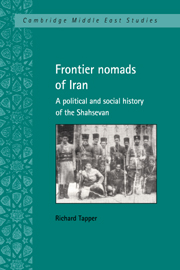Book contents
- Frontmatter
- Contents
- List of illustrations
- Preface
- Acknowledgments
- Note on transliteration
- Glossary
- 1 Writing tribal history
- PART I The Safavid state and the origins of the Shahsevan
- PART II The rise of the Shahsevan confederacy
- PART III The Shahsevan tribes in the Great Game
- PART IV The end of the tribal confederacy
- Appendices
- 1 The Shahsevan of Kharaqan and Khamseh
- 2 Lists and histories of Shahsevan tribes
- 3 Some Shahsevan voices
- Bibliography
- Index of topics
- Index of places, peoples, persons, dynasties, parties, companies
- Index of authors quoted or discussed
- Index of tribal names
- Plate section
2 - Lists and histories of Shahsevan tribes
Published online by Cambridge University Press: 05 March 2012
- Frontmatter
- Contents
- List of illustrations
- Preface
- Acknowledgments
- Note on transliteration
- Glossary
- 1 Writing tribal history
- PART I The Safavid state and the origins of the Shahsevan
- PART II The rise of the Shahsevan confederacy
- PART III The Shahsevan tribes in the Great Game
- PART IV The end of the tribal confederacy
- Appendices
- 1 The Shahsevan of Kharaqan and Khamseh
- 2 Lists and histories of Shahsevan tribes
- 3 Some Shahsevan voices
- Bibliography
- Index of topics
- Index of places, peoples, persons, dynasties, parties, companies
- Index of authors quoted or discussed
- Index of tribal names
- Plate section
Summary
The value of tribal lists as documents is qualified by their nature and inherent interest as social constructions (see Chapter Fourteen), which leads, among other variations, to considerable differences in length. For example, among official lists I collected in the 1960s, one given by a senior official responsible for the Ministry of Agriculture's relations with the Shahsevan amounted to forty-eight tribes; another, by the Moghan Office of Tribes, numbers forty; while the Meshkin gendarmerie's 1963 list numbered twenty-one. Only a few discrepancies in length and content were due to differences of jurisdiction.
In the sources, tribes are sometimes ordered according to size and importance, sometimes according to territorial propinquity or common origins. There is no obviously preferable order, so in the list, and the accompanying table (Figure 12), I have listed the tribes alphabetically (as did the recent Census, though according to the Persian alphabet), within four categories:
The tribes of Meshkin
The tribes of Ardabil
Tribes that have settled/disappeared since about 1900
Tribes that have emerged since about 1900.
With transliteration of tribal names, I have attempted a compromise between the usually Persianized literary versions and a phonetic version of how they are pronounced by Shahsevan themselves.
- Type
- Chapter
- Information
- Frontier Nomads of IranA Political and Social History of the Shahsevan, pp. 356 - 374Publisher: Cambridge University PressPrint publication year: 1997



